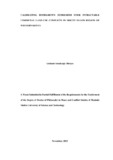CALIBRATING HOMEGROWN EXTREMISM OVER INTRACTABLE COMMUNAL LAND USE CONFLICTS IN MOUNT ELGON REGION OF WESTERN KENYA
Abstract
Since the end of the cold war, violent interstate conflicts have been historically low. However, in the post-Cold War world order, conflicts within states among a ballooning number of extremist militia groups, non-state armed groups and the state thereby prompting external intervention have been on the upsurge. In the Global South, intra-state contestations over land and natural resource distribution have become rampant. These are projected to rise as a domino effect of population explosion, urbanization, adverse effects of climate change and deteriorating land quality. The African Continent is set to bear the biggest burden of these contestations. Therefore, guided by the Pragmatic Africanacity philosophy, this thesis is a departure from conventional Euro-American drivers of extremism. Therefore, a new phase of violent extremism over land and resource distribution could be on the horizon. Coupled with the already complex challenges presented by conventional extremist organizations, is set to redefine the Global counter violent extremism architecture. In Kenya, land is essential to human survival, development and is a source of livelihood. Pursuit for land shrouded by relative deprivation can contribute to feelings of grievance and injustice. Without cogent moderation by the state, land injustices are a rehearsal to social tensions as they feed into pre-existing conflict dynamics and can escalate into violent conflicts. Existing literature has not been explicit on the intimacy between distribution of land and natural resources as a pathway to homegrown extremism. This study sought to bring forth this relationship. Rooted in a long historical quest for land rights spanning over 100 years, the carnage of the Soy led extremist Sabaot Land Defense Forces epitomized state failure to secure sustainable peace over land distribution in Mt. Elgon Region. In as much as tracks one and two peace approaches managed to secure some semblance of tranquility in the region not much has been documented about their commissions and omissions as catalysts to extremism. The general objective of this study was to calibrate homegrown extremism over intractable communal land use conflicts in Mt. Elgon Region of Western Kenya. The specific objectives of the study were to: Examine the determinants of homegrown extremism over intractable communal land use conflicts in Mt. Elgon Region; Investigate the risk of homegrown extremism over intractable communal land use conflicts in Mt. Elgon Region and assess the contribution of the response approaches to extremism in their quest to manage intractable land use conflicts in Mt. Elgon Region. The study was anchored on Relative Deprivation and the Frustration Aggression theories. The study adopted descriptive and historical research designs. The target population comprised 452 respondents sampled from households, ex-SLDF combatants, community elders and victims of land conflicts. Quantitative data was analyzed descriptively by computing measures of central tendency, frequency counts and percentages. Qualitative data was analyzed thematically and presented through narratives and verbatim quotations. Study findings on specific objective one established that the determinants of homegrown extremism included: socio-demographic variables (strongly supported) political leadership (58%); land tenure insecurity (96%); Perceived marginalization of the Sabaot community (92%); Forced government eviction programs (100%); Disputed boundaries (91%) and land as a source of identity (56%) among others. Study findings on specific objective two pointed to a high risk for attitudinal, contextual, historical, protective, demographic, persuasive, coercive, preventive, public health/psychological were all supported. Study findings on the contribution of response approaches to homegrown extremism revealed inaccessibility to Ministry of lands (87%), Inaccessibility to National Lands Commission (93%), gross violations by police (93%), lack of justice and lack of access to County Governments (98). Overall, study findings concluded that the caliber of extremism in Mt. Elgon Region of Western Kenya is high. This has in the past, present and in future if not conclusively addressed will continue to feed to the equation intractable land use conflicts in the the study area. Policy recommendations included the need for: a multi-sectoral human needs based development approach to address the multivariate determinants; adoption of risk assessment tools for timely detection and prevention of the risk of extremism by state security agencies and the need for stakeholders to expedite and conclusively address the land question in the study area in an effort to manage homegrown extremism. Understanding the taxonomy of external versus homegrown determinants of extremism, examination of public health risk factors for extremism and an assessment of the role of devolution in managing center-periphery causes of extremism within counties were recommended for further studies.

